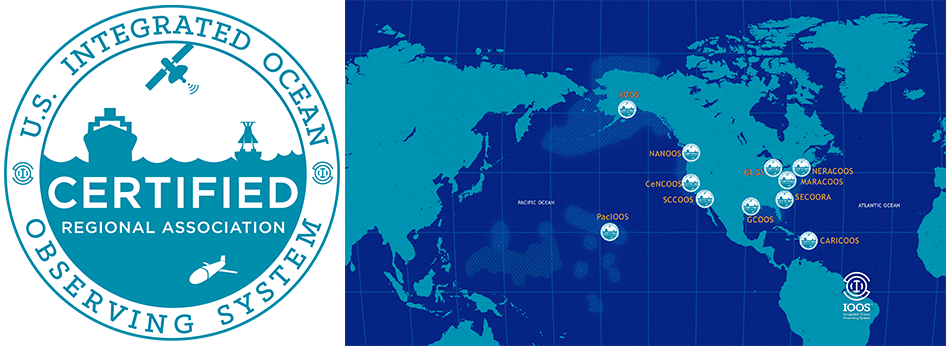About Us
The Southern California Coastal Ocean Observing System (SCCOOS) is one of eleven regions that contributes to the national U.S. Integrated Ocean Observing System (IOOS®). The regional observing systems work to collect, integrate, and deliver coastal and ocean observations in order to improve safety, enhance the economy, and protect the environment. The principal goal of SCCOOS is to provide observations and products to a diverse stakeholder community of managers and planners, operational decision makers, scientists, and the general public. As the regional observing system for Southern California, SCCOOS, has developed the capabilities to support short-term decision-making and long-term assessment by implementing and leveraging biological, chemical, and physical observations and models, many of which are available in near real-time. SCCOOS priorities and objectives are aligned with the seven societal goals as outlined in the IOOS Summit Report. The focus themes, as designated by IOOS, highlight these priorities and are designed to improve safety, enhance the economy, and protect our environment.
Focus Areas:
Climate Variability and Change: to operate and maintain a network of gliders to collect measurements of temperature, salinity, chlorophyll, current velocity, dissolved oxygen, and acoustic backscatter; deliver data to SCCOOS website and push to modeling centers, and to continue to develop integrate and enhance long-term time series products for distribution.
Ecosystems, Fisheries, and Water Quality: to monitor ocean climate trends and environmental changes in the Southern California Bight by collecting physical, chemical, and biological data and to provide monitoring, tracking, and prediction tools for harmful algal blooms, outfall and stormwater plumes, and surf zone contaminants.
Coastal Hazards: to provide accurate, validated inundation models and information with the long-term goal of improving coastal safety.
Marine Operations: to advance integrated, customized products that are critical for safe and efficient navigation, search and rescue, and oil spill response.
Science Education and Communication: to provide visualizations and resources for the public to learn, educate, and promote scientific research using data obtained from SCCOOS.
Certified Regional Information Coordination Entity
In December 2016, IOOS certified SCCOOS as a Regional Information Coordination Entity (RICE). Certification is a key milestone to the establishment of the full IOOS system and is mandated in the Integrated Coastal and Ocean Observation System Act of 2009 (ICOOS Act). Certification means that SCCOOS is providing high-quality observations to National-level standards and extending the reach and ability of Federal programs.

History
In the fall of 2002, SCCOOS began the initial design and development of a stakeholder-driven organizational development strategy to enhance and promote the organization, implementation, and application of a regional coastal ocean observing system in Southern California.
In the spring of 2005, the Senate and the House of Representatives enacted a bill called, “Coastal Ocean Observation System Integration and Implementation Act of 2005” to create an establishment of a US Coastal Ocean Observation system.
On March 30, 2009, President Barack Obama signed the Integrated Coastal and Ocean Observation System Act of 2009 into law. The Act authorizes the establishment of a National Integrated Ocean Observing System (IOOS) and codifies a governance structure within which that System will operate.
Today at the local level, SCCOOS works closely with regional and state mission agencies to develop science-based products to further their work. Representatives include public health, regional water control boards, ocean dischargers that include sewer districts and municipalities, private industry including energy producers, marine safety officers, local Navy and Coast Guard personnel, and the commercial shipping industry. SCCOOS is also a collaborative network of scientists and research teams at universities and institutions that collect and aggregate coastal ocean data to provide a single online portal for distribution. Federal funding is leveraged with existing projects with both the State Water Resources Control Board and the California State Coastal Conservancy.
